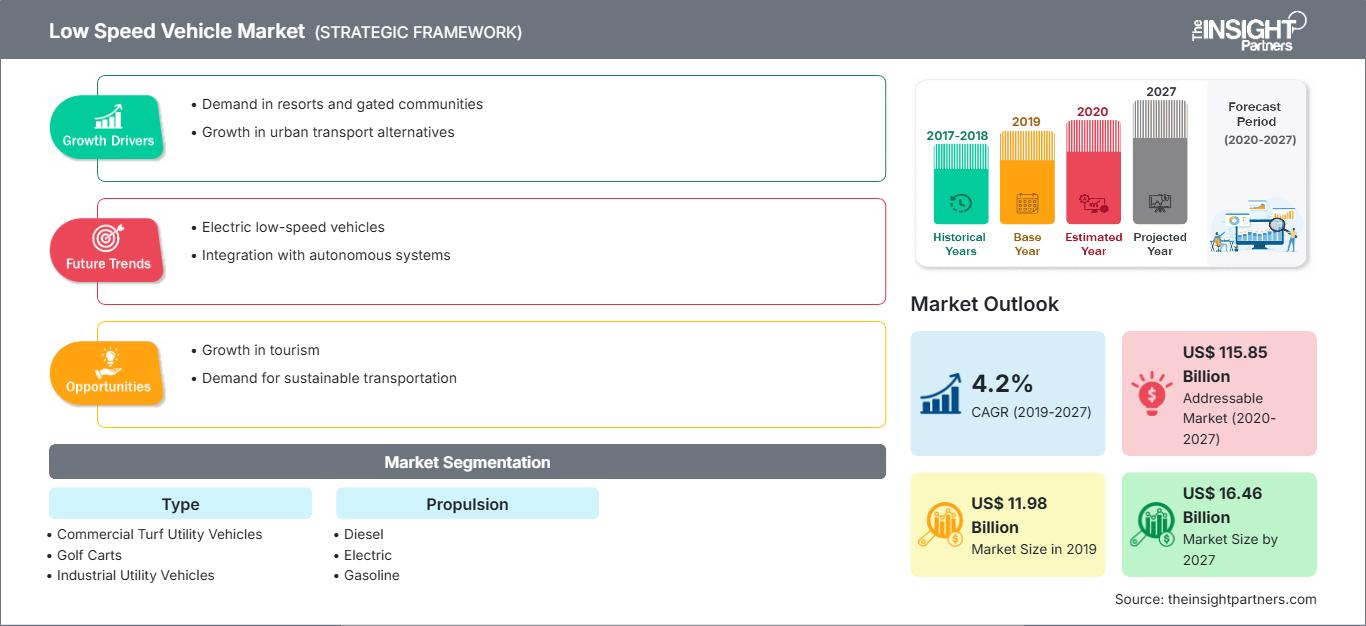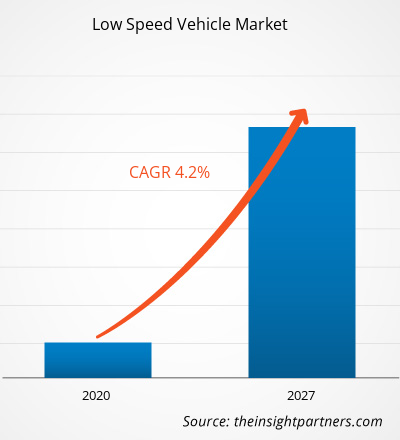El mercado de vehículos de baja velocidad se valoró en 11.980 millones de dólares estadounidenses en 2019 y se espera que crezca a una tasa de crecimiento anual compuesta (TCAC) del 4,2% entre 2020 y 2027, hasta alcanzar los 16.460 millones de dólares estadounidenses en 2027.
El mercado de vehículos de baja velocidad ha experimentado un crecimiento notable a nivel mundial en los últimos años. Las perspectivas económicas positivas, el aumento de la renta disponible y el crecimiento demográfico son algunos de los factores que impulsan la demanda de proyectos de infraestructura. Asimismo, el elevado volumen de pedidos en línea y el auge del comercio electrónico conllevan una mayor demanda de almacenes en la región. Los vehículos de baja velocidad facilitan el traslado de cajas dentro de los almacenes. Estos factores desempeñan un papel fundamental en la aceleración del crecimiento del mercado de vehículos de baja velocidad. La región Asia-Pacífico ostentó la mayor cuota de mercado en 2019 y se prevé que sea la de mayor crecimiento. Norteamérica y Europa ocupan el segundo y tercer lugar, respectivamente, en este mercado.
El brote de coronavirus comenzó en Wuhan (China) en diciembre de 2019. Se ha propagado rápidamente por todo el mundo y algunos de los países más afectados son China, Italia, Irán, España, Corea del Sur, Francia, Alemania y Estados Unidos. El brote de COVID-19 y sus consecuencias, como el cierre de fronteras, las paralizaciones y las restricciones de viaje, han comenzado a impactar a empresas de diversos sectores. Se prevé que el mercado de vehículos de baja velocidad se vea afectado de forma moderada debido a las interrupciones en las cadenas de suministro globales. Las empresas que operan en este mercado experimentarán una caída en las ventas totales a corto plazo (de 3 a 6 meses); sin embargo, se espera un crecimiento sostenido en los próximos años.
Obtendrá personalización gratuita de cualquier informe, incluyendo partes de este informe, análisis a nivel de país y paquetes de datos de Excel. Además, podrá aprovechar excelentes ofertas y descuentos para empresas emergentes y universidades.
Mercado de vehículos de baja velocidad: Perspectivas estratégicas

-
Obtenga las principales tendencias clave del mercado que se describen en este informe.Esta muestra GRATUITA incluirá análisis de datos, que abarcarán desde tendencias de mercado hasta estimaciones y pronósticos.
Perspectivas del mercado
Aumento de las iniciativas gubernamentales para fomentar el transporte sostenible
La Unión Europea, China, Japón, Canadá, India y Corea del Sur son algunas de las principales regiones donde los gobiernos están tomando medidas proactivas para impulsar la adopción de vehículos eléctricos. Por ejemplo, en la Unión Europea se introdujeron mejoras significativas en los estándares de eficiencia de combustible para los vehículos existentes. Se formuló la Directiva de Vehículos Limpios para la adquisición de autobuses eléctricos por parte del sector público. Asimismo, se creó otra directiva, la Directiva de Eficiencia Energética de Edificios, que establece estándares mínimos para la instalación de infraestructura de recarga en edificios.
Perspectivas de propulsión
El mercado de vehículos de baja velocidad, según su sistema de propulsión, se segmenta en diésel, eléctrico y gasolina. El segmento de combustible acaparó la mayor parte del mercado global de vehículos de baja velocidad. Se observa una creciente tendencia hacia los vehículos de alta potencia, capaces de circular por las vías permitidas y que pueden utilizarse como vehículos utilitarios y de transporte de personal. Por lo tanto, durante el período de previsión, se proyecta un crecimiento significativo de los vehículos eléctricos de baja velocidad, junto con los vehículos de alta potencia de baja velocidad, lo que a su vez impulsará el mercado de vehículos de baja velocidad.
Información sobre tipos
El mercado de vehículos de baja velocidad, por tipo, se segmenta en vehículos utilitarios comerciales para mantenimiento de césped, carritos de golf, vehículos utilitarios industriales y vehículos de transporte de personal. El segmento de carritos de golf dominó el mercado global de vehículos de baja velocidad. Varias comunidades en Estados Unidos dependen en gran medida de vehículos eléctricos de baja velocidad para su transporte. Para las personas mayores, caminar a veces puede resultar difícil, mientras que conducir un automóvil puede ser engorroso e incluso peligroso.
Las empresas suelen adoptar iniciativas de mercado y nuevas estrategias de desarrollo para expandir su presencia mundial y satisfacer la creciente demanda. Estas estrategias se observan principalmente en Norteamérica y Europa. Los actores del mercado de vehículos de baja velocidad adoptan la estrategia de expansión e inversión en investigación y desarrollo para ampliar su base de clientes a nivel mundial, lo que también les permite mantener su marca a nivel global.
Perspectivas regionales del mercado de vehículos de baja velocidad
Los analistas de The Insight Partners han explicado en detalle las tendencias y los factores regionales que influyen en el mercado de vehículos de baja velocidad durante el período de previsión. Esta sección también analiza los segmentos y la geografía del mercado de vehículos de baja velocidad en Norteamérica, Europa, Asia Pacífico, Oriente Medio y África, y Sudamérica y Centroamérica.
Alcance del informe de mercado de vehículos de baja velocidad
| Atributo del informe | Detalles |
|---|---|
| Tamaño del mercado en 2019 | 11.980 millones de dólares estadounidenses |
| Tamaño del mercado para 2027 | 16.460 millones de dólares estadounidenses |
| Tasa de crecimiento anual compuesto global (2019 - 2027) | 4,2% |
| Datos históricos | 2017-2018 |
| período de previsión | 2020-2027 |
| Segmentos cubiertos |
Por tipo
|
| Regiones y países cubiertos |
América del norte
|
| Líderes del mercado y perfiles de empresas clave |
|
Densidad de actores del mercado de vehículos de baja velocidad: comprensión de su impacto en la dinámica empresarial
El mercado de vehículos de baja velocidad está creciendo rápidamente, impulsado por la creciente demanda de los usuarios finales debido a factores como la evolución de las preferencias de los consumidores, los avances tecnológicos y una mayor conciencia de los beneficios del producto. A medida que aumenta la demanda, las empresas amplían su oferta, innovan para satisfacer las necesidades de los consumidores y aprovechan las nuevas tendencias, lo que impulsa aún más el crecimiento del mercado.

- Obtenga una visión general de los principales actores del mercado de vehículos de baja velocidad.
Mercado de vehículos de baja velocidad – Por tipo
- Vehículos utilitarios comerciales para césped
- Carritos de golf
- Vehículos utilitarios industriales
- Vehículos de transporte de personal
Mercado de vehículos de baja velocidad – Por propulsión
- Diesel
- Eléctrico
- Gasolina
Mercado de vehículos de baja velocidad – Por geografía
-
América del norte
- A NOSOTROS
- Canadá
- México
-
Europa
- Francia
- Alemania
- Italia
- Reino Unido
- Rusia
- El resto de Europa
-
Asia Pacífico
- Porcelana
- India
- Australia
- Corea del Sur
- Japón
- Resto de Asia Pacífico
-
Oriente Medio y África
- Sudáfrica
- Arabia Saudita
- Emiratos Árabes Unidos
- Resto de Oriente Medio y África
-
Sudamerica
- Brasil
- Argentina
- El resto de Sudamérica
Perfiles de empresas
- Vehículo eléctrico Bintelli
- Club Car, LLC
- Cruise Car, Inc.,
- Deere y compañía
- HDK Co., Ltd.
- Vehículos eléctricos Moto
- Polaris Inc.
- Textron Vehículos Especializados Inc.
- La compañía Toro
- Compañía de carros de golf Yamaha
- Análisis histórico (2 años), año base, pronóstico (7 años) con CAGR
- Análisis PEST y FODA
- Tamaño del mercado, valor/volumen: global, regional y nacional
- Industria y panorama competitivo
- Conjunto de datos de Excel
Informes recientes
Informes relacionados
Testimonios
Razón para comprar
- Toma de decisiones informada
- Comprensión de la dinámica del mercado
- Análisis competitivo
- Información sobre clientes
- Pronósticos del mercado
- Mitigación de riesgos
- Planificación estratégica
- Justificación de la inversión
- Identificación de mercados emergentes
- Mejora de las estrategias de marketing
- Impulso de la eficiencia operativa
- Alineación con las tendencias regulatorias






















 Obtenga una muestra gratuita para - Mercado de vehículos de baja velocidad
Obtenga una muestra gratuita para - Mercado de vehículos de baja velocidad